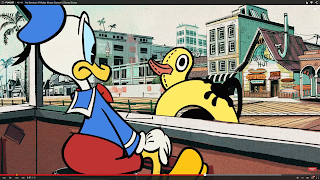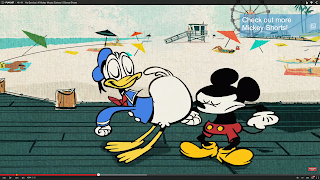Principle 1 - Squash and Stretch

There are tons of examples of squash and stretch in this cartoon. Every facial expression goes through a squash and stretch process of it's own to showcase anticipation. In this case, we have one of the many examples of squash and stretch in the body. Mickey is falling from the sky at high acceleration. As he lands, his entire body squashes to the floor, then stretched back up before it neutralises.
Principle 2 - Anticipation
Here we see an example of Anticipation. Examples of this are thrown around all over the cartoon, it is almost distinctly a style of animation. Every action, no matter how small or big has a very obvious wind up to show anticipation. In this case, Mickey Mouse has an idea. He shrinks his body to show anticipation and stretches it up and out, pointing his finger into the air.
Principle 3 - Staging
Here we see a long hand pointing at the sign on the door while Donald and Mickey are at either side looking at said sign. Everything about the staging leads your eye to the sign as well until the next shot zooms right into it. The question marks are a bit of an overkill but they do demonstrate Donald and Mickeys surprise as well as shock as the question marks are in red.
Principle 4 - Straight ahead and Pose to Pose
This looks like straight ahead animation; Mickey begins on one end of the gate and as he walks behind it his body parts swirl around and through the iron design. Because the motion is so fluid and unpredictable, we can assume that the animators used straight ahead animation.
For something like this 'waddle' sequence, we can assume that the animator used pose to pose animation illustrating the extreme key poses first and then going through and animating the in-between transitions.
Principle 5 - Follow-Through and Overlapping Action
Here is one example of follow-through and overlapping action. As goofy moves around, his years trail after him a bit delayed.
Here is another example of this. Notice Donald Ducks hat accessory drag as he moves his head back in surprise, then follow through and settle down on it's own after Donald has stopped his head motion.
Principle 6 - Slow-In, Slow-Out
This is a very good example of the slow in and slow out effect. Mickey Mouse is swirling round with a gust of wind in loops. As he approaches the top of the loop of motion, his body slows down before he very swiftly drops into the circular motion again.
Principle 7 - Arcs
Again, there is a plethora of these principles in this one single short but I picked out my favourite demonstration of Arcs. Here, Donald Duck is pointing his tail feathers at Mickey. He Anticipates the motion to the left and then follows a very clear arc over to the right. After which, is rear end follows it's own arc (more like a circle) and settles at the top with his tail feathers. This was a very quick motion that slowed down at the settling of the tail.
Principle 8 - Secondary Action
In this shot, Goofy delivers the line 'I'm trying to run a classy establishment here' in his sloppy southern accent. To maximise on this quote, we see the secondary action of his squashing a bug with his spatula and then using that same spatula to flip a patty. This reinforces and exaggerated the irony of the reality of the situation juxtaposed with Goofy's remark.
Another example: Here Mickey is speaking with the girls as he catches a falling bag of food with his left hand while his right hand straightens his bow tie. What we notice first is his catching of the food followed by the straightening of the bow tie. The secondary action is the action involving the bow tie.
Principle 9 - Timing
Timing here: Donald Duck is laughing, Mickey Mouse pops in his head, he is clearly angry. He calls for Donald's attention and Donald responds with his head. Then we zoom into Mickeys face as he takes notice of their girlfriends rapidly approaching from the distance. Everything is spaced out in a way that carries our eye very smoothly through the events occurring. We see Donald laughing, then Mickey then we notice Donald's reaction. There are many examples 'call and response' timing in this short.
Principle 10 - Exaggeration
Mickey is being being impacted by a leaf blower. His face stretches out to unrealistic proportions and his limbs flop around as if they are made of string.
In this shot, we see Daffy go through a series of extreme poses and exaggerations. First he sees Mickey, follows him as he crashes into a building, anticipates his laugh by exaggerating and scrunching his body into a ball and then throwing his head back in an exaggerated laugh.
Principle 11 - Drawing
In this short, the characters all go through different weights and volumes as their bodies are put through different experiences. In the shot where Mickey is being blown around in a gust of wind, it seems he is as light as a feather as opposed to the scene just before in which he is blown by at leaf blower where he manages to hold his ground.
As Mickey lands elegantly in front of the girls fully clothed, his body squashes and stretches showing that his body may be made up of rubbery material.
Principle 12 - Character Appeal
All of the characters in this short are based on Disney characters how ever they do carry their own flair. The design is a lot sharper and exaggerated. Their heads are a lot bigger and their bodies much smaller than the originals. Their facial expressions as well as body movements are pushed to the limit as opposed to the original characters which are a bit 'safer' in design.
Here are two videos for comparison:

















































No comments:
Post a Comment